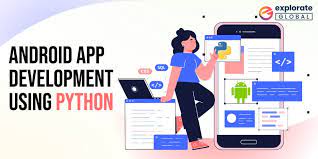The Power of Python in Android App Development
Python, known for its simplicity and versatility, has gained popularity in the world of mobile app development, including the realm of Android apps. With its clean syntax and ease of use, Python offers developers a powerful tool to create innovative and efficient applications for the Android platform.
One of the key advantages of using Python for Android app development is its cross-platform compatibility. Developers can write code once and deploy it across multiple platforms, saving time and effort in the development process. This makes Python a cost-effective choice for businesses looking to reach a wider audience with their mobile apps.
Furthermore, Python’s extensive library support provides developers with a wide range of tools and resources to streamline the app development process. From data processing to web integration, Python libraries such as Kivy and Pyqt help developers build robust and feature-rich Android applications.
Another benefit of using Python for Android app development is its strong community support. Developers can easily find resources, tutorials, and forums online to help them overcome challenges and stay updated on the latest trends in mobile app development.
In conclusion, Python offers developers a versatile and efficient platform for creating cutting-edge Android applications. Its simplicity, cross-platform compatibility, extensive library support, and strong community make it an ideal choice for businesses looking to develop high-quality mobile apps that stand out in today’s competitive market.
Six Essential Tips for Developing Python Android Apps: Frameworks, Optimization, and Compatibility Best Practices
- Use a framework like Kivy or BeeWare for developing Python-based Android apps.
- Optimize your app for mobile devices to ensure smooth performance.
- Implement responsive design to adapt your app to different screen sizes and orientations.
- Utilize Android APIs and libraries through tools like Pyjnius or Chaquopy.
- Consider the limitations of Python on mobile platforms, such as slower speed compared to native languages.
- Test your app thoroughly on Android devices to identify and fix any compatibility issues.
Use a framework like Kivy or BeeWare for developing Python-based Android apps.
When embarking on Python Android app development, utilizing a framework such as Kivy or BeeWare can significantly enhance the development process. These frameworks provide developers with powerful tools and resources to create feature-rich and visually appealing Android applications using Python. By leveraging the capabilities of frameworks like Kivy or BeeWare, developers can streamline the app development process, improve efficiency, and ultimately deliver high-quality apps that meet the demands of today’s mobile users.
Optimize your app for mobile devices to ensure smooth performance.
To ensure smooth performance of your Python Android app, it is crucial to optimize it for mobile devices. By focusing on optimizing the app’s code, design, and resources for mobile platforms, developers can enhance user experience, reduce loading times, and minimize battery consumption. Implementing best practices for mobile optimization, such as minimizing network requests, optimizing images and multimedia content, and prioritizing responsive design principles, can help ensure that your app runs efficiently on a wide range of Android devices. Prioritizing mobile optimization in the development process is key to delivering a seamless and enjoyable user experience for your app’s users.
Implement responsive design to adapt your app to different screen sizes and orientations.
Implementing responsive design is crucial in Python Android app development to ensure that your app can adapt seamlessly to various screen sizes and orientations. By incorporating responsive design principles, you can create a user-friendly experience for your app users across different devices, whether they are using smartphones or tablets in portrait or landscape mode. This approach not only enhances the visual appeal of your app but also improves usability and accessibility, ultimately leading to higher user satisfaction and engagement.
Utilize Android APIs and libraries through tools like Pyjnius or Chaquopy.
To enhance the functionality and performance of Python Android app development, developers can leverage the power of Android APIs and libraries by utilizing tools like Pyjnius or Chaquopy. These tools provide seamless integration with native Android components, allowing developers to access a wide range of features and resources to create robust and feature-rich applications. By tapping into Android APIs and libraries, developers can enhance the user experience, improve app performance, and unlock new possibilities for innovation in their Python-based Android apps.
Consider the limitations of Python on mobile platforms, such as slower speed compared to native languages.
When embarking on Python Android app development, it is crucial to consider the limitations of Python on mobile platforms, such as its slower speed compared to native languages. While Python offers simplicity and versatility, its performance may not match that of languages specifically optimized for mobile development. Developers should carefully assess the speed requirements of their app and consider potential performance trade-offs when choosing Python for Android app development. By acknowledging these limitations upfront, developers can make informed decisions to optimize their app’s performance and deliver a seamless user experience on the Android platform.
Test your app thoroughly on Android devices to identify and fix any compatibility issues.
Testing your Python Android app thoroughly on a range of Android devices is crucial to ensure optimal performance and user experience. By testing on different devices, you can identify and address any compatibility issues that may arise, such as layout problems or functionality errors. This proactive approach not only helps in delivering a seamless app experience for users but also enhances the overall quality and reliability of your application.


Leave a Reply